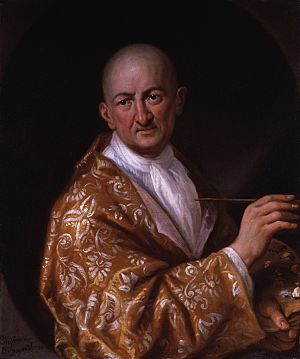Antonio Verrio facts for kids
Quick facts for kids
Antonio Verrio
|
|
|---|---|

Self-portrait of Antonio Verrio circa 1705/6
|
|
| Born | circa 1636 |
| Died | 15 June 1707 |
| Nationality | Italian |
| Known for | Painting |
| Movement | Baroque |
Antonio Verrio (born around 1636 – died June 15, 1707) was a talented Italian painter. He is famous for bringing a new style of art, called Baroque mural painting, to England. He worked for the English kings and queens for about 30 years.
Antonio Verrio's Painting Journey
Verrio was born in Lecce, a city in what was then the Kingdom of Naples. He started his painting career there. He learned from a painter named Giovanni Andrea Coppola. You can still see some of Verrio's early paintings in Lecce today. One of his first known works is S. Francesco Saverio appare al Beato Marcello Mastrilli.
Around 1665, Verrio moved to France. He worked near Toulouse, decorating a grand house called the Château de Bonrepos. This house belonged to Pierre-Paul Riquet, who helped build the famous Canal du Midi. Verrio then settled in Toulouse itself. He painted for churches there. Two of his paintings, Le Mariage de la Vierge and Saint-Félix de Cantalice, are now in the Musée des Augustins. Around 1670, Verrio moved to Paris. He started painting for rich families and decorated several private homes.
In March 1672, Verrio traveled to England. He was recommended by Ralph Montagu, who was an English ambassador in Paris. Thanks to Montagu, Verrio began working for important people in England. These included the Earl of Arlington and the Duke of Lauderdale. Soon, he also started working for King Charles II.
By 1675, Verrio had painted a beautiful picture of King Charles II. It was called The Sea Triumph of Charles II. On May 5 of that year, he officially became a resident of England. Soon after, he got his most important job. He was asked to decorate the North Range of Windsor Castle. He worked with architect Hugh May and sculptor Grinling Gibbons. This huge project included painting 20 ceilings, three staircases, the King's Chapel, and St George's Hall. He was paid a very large amount of money for this work. When he finished in 1684, Verrio was named the 'Chief First Painter' to the King. Sadly, most of these paintings were changed later. Only three ceilings from his work at Windsor Castle still exist today.
When James II became king, Verrio continued his royal service. He decorated Whitehall Palace (which later burned down) and Henry VIII's Chapel at Windsor. In March 1685, he was also put in charge of the Great Garden in St James's Park. But when William III became king after a big change in power, Verrio lost his royal job.
Verrio then went back to working for rich families. For the next ten years, he painted at Burghley House and Chatsworth House. Both of these houses are great examples of English Baroque art. Burghley House has Verrio's masterpiece, the Heaven Room. By 1699, King William III invited Verrio back to court. After working at Windsor again, Verrio decorated Hampton Court Palace for William. When William died in 1702, Verrio continued to work for Queen Anne. He painted his last royal artwork in the Queen's Drawing Room. In 1705, Queen Anne gave Verrio a yearly payment of £200. She also let him keep his home at Hampton Court. Before he died on June 15, 1707, Verrio painted several portraits, including a picture of himself. This self-portrait is now in the National Portrait Gallery.
Antonio Verrio's work influenced younger artists like Louis Laguerre. His amazing paintings at Hampton Court Palace are still cared for today. They are an important part of art history.
Where to See Antonio Verrio's Art
You can see Antonio Verrio's decorative paintings in England and Wales at many places. These include Burghley House, Chatsworth House, Reigate Priory, Royal Hospital Chelsea, Christ's Hospital, Ham House, Hampton Court Palace, Moor Park, Powis Castle, Snape Castle (though it's in poor condition), and Windsor Castle.
Some of his other paintings, sketches, and drawings are in different collections. You can find them at the British Museum, Fitzwilliam Museum in Cambridge, National Portrait Gallery, Northampton Museum and Art Gallery, Royal Collection, and the Victoria and Albert Museum.
In France, you can see his art in Toulouse at the musée des Augustins and Saint Exupère's church. In Paris, he painted some ceilings in the Hôtel Brûlart. In Italy, his paintings are in various churches and the provincial museum of Lecce, his hometown.
Gallery of Verrio's work






